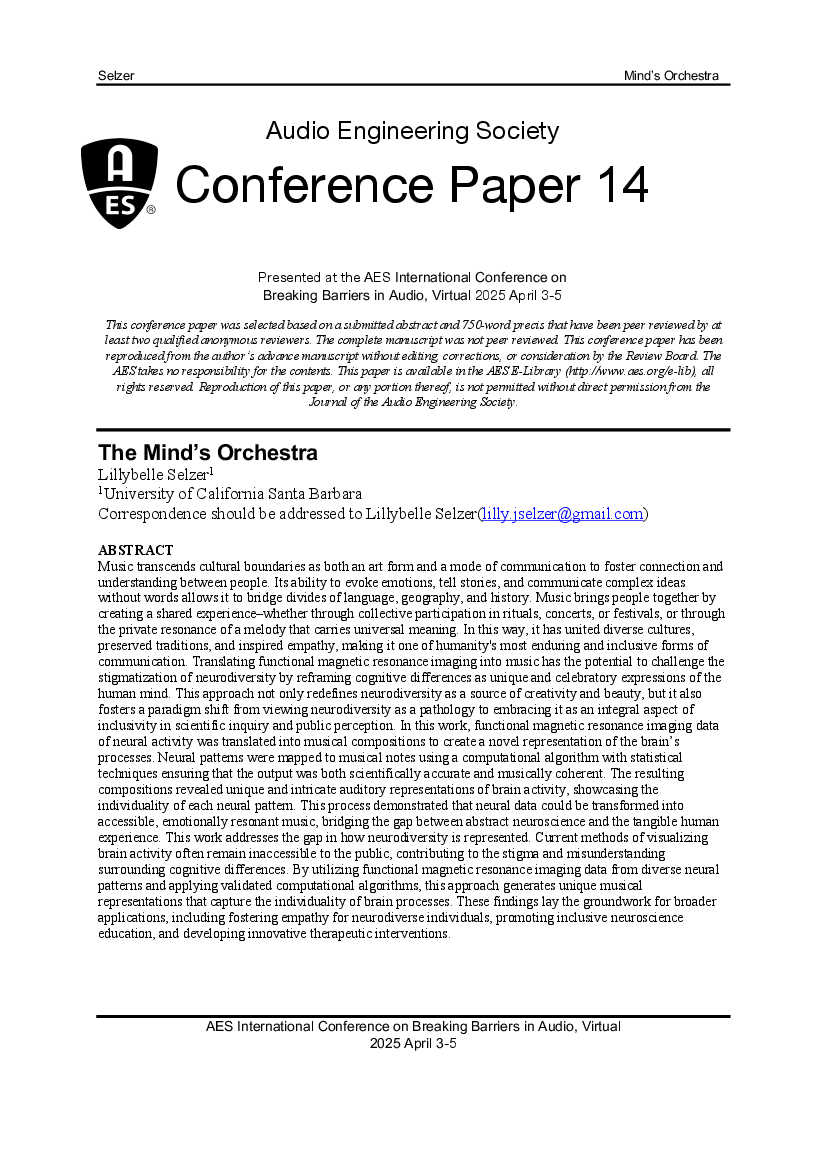Home / Publications / E-library page
You are currently logged in as an
Institutional Subscriber.
If you would like to logout,
please click on the button below.
Home / Publications / E-library page
Only AES members and Institutional Journal Subscribers can download
Music transcends cultural boundaries as both an art form and a mode of communication to foster connection and understanding between people. Its ability to evoke emotions, tell stories, and communicate complex ideas without words allows it to bridge divides of language, geography, and history. Music brings people together by creating a shared experiencewhether through collective participation in rituals, concerts, or festivals, or through the private resonance of a melody that carries universal meaning. In this way, it has united diverse cultures, preserved traditions, and inspired empathy, making it one of humanity`s most enduring and inclusive forms of communication.
Translating functional magnetic resonance imaging (fMRI) into music has the potential to challenge the stigmatization of neurodiversity by reframing cognitive differences as unique and celebratory expressions of the human mind. This approach not only redefines neurodiversity as a source of creativity and beauty, but it also fosters a paradigm shift from viewing neurodiversity as a pathology to embracing it as an integral aspect of inclusivity in scientific inquiry and public perception.
In this work, fMRI data of neural activity was translated into musical compositions to create a novel representation of the brains processes. Neural patterns were mapped to musical notes using a computational algorithm with statistical techniques ensuring that the output was both scientifically accurate and musically coherent. The resulting compositions revealed unique and intricate auditory representations of brain activity, showcasing the individuality of each neural pattern. This process demonstrated that neural data could be transformed into accessible, emotionally resonant music, bridging the gap between abstract neuroscience and the tangible human experience.
This work addresses the gap in how neurodiversity is represented. Current methods of visualizing brain activity often remain inaccessible to the public, contributing to the stigma and misunderstanding surrounding cognitive differences. By utilizing fMRI data from diverse neural patterns and applying validated computational algorithms, this approach generates unique musical representations that capture the individuality of brain processes. These findings lay the groundwork for broader applications, including fostering empathy for neurodiverse individuals, promoting inclusive neuroscience education, and developing innovative therapeutic interventions.
Author (s): Selzer, Lillybelle
Affiliation:
UCSB
(See document for exact affiliation information.)
Publication Date:
2025-03-27
Import into BibTeX
Session subject:
Breaking Barriers in Audio
Permalink: https://aes2.org/publications/elibrary-page/?id=22835
(283KB)
Click to purchase paper as a non-member or login as an AES member. If your company or school subscribes to the E-Library then switch to the institutional version. If you are not an AES member Join the AES. If you need to check your member status, login to the Member Portal.

Selzer, Lillybelle; 2025; The Mind's Orchestra [PDF]; UCSB; Paper 12; Available from: https://aes2.org/publications/elibrary-page/?id=22835
Selzer, Lillybelle; The Mind's Orchestra [PDF]; UCSB; Paper 12; 2025 Available: https://aes2.org/publications/elibrary-page/?id=22835